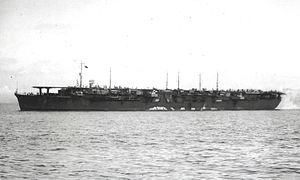avia.wikisort.org - Aircraft_carrier
The Chitose-class aircraft carriers (千歳型航空母艦, Chitose-gata kōkūbokan) were a class of two seaplane tenders, later converted to light aircraft carriers, of the Imperial Japanese Navy during World War II. Under the terms of the Washington Naval Treaty, the total tonnage of Japan's naval vessels was limited by class. The Chitose-class ships were built as seaplane tenders, designed to make the conversion to aircraft carriers relatively easy. They served as seaplane tenders during the early part of the Pacific War. After the Battle of Midway, they were converted into light aircraft carriers. Both ships participated in the Battle of the Philippine Sea and both were sunk in the Battle of Leyte Gulf.
This article includes a list of references, related reading or external links, but its sources remain unclear because it lacks inline citations. (January 2013) |
Chitose (千歳) underwent conversion at the Sasebo Naval Yard and was completed on New Years Day, 1944. Her sister ship Chiyoda (千代田) was completed approximately two months earlier at the Yokosuka Naval Yard. Both ships were outfitted with a single hangar and they were widened by an additional 6 feet 7 inches (2.0 m). The added flight deck was serviced by two lifts.

Chitose and Chiyoda were sunk at the Battle off Cape Engaño, which occurred during the Imperial Japanese Navy's "Sho-Go" operation that produced the Battle of Leyte Gulf. In charge of the operation was Vice Admiral Jisaburo Ozawa, commander of the operation's northern force. Ozawa's was a desperate mission—provide an attractive target for U.S. Admiral William F. Halsey's Third Fleet, hopefully pulling the powerful American "fast carriers" north so that Japanese surface ships could slip in and attack U.S. invasion forces off Leyte. His ships were not expected to survive their diversionary employment. Together with two other carriers in the group, they carried only 116 planes, much less than their normal capacity and far less than the aircraft of Halsey's task forces.
Despite their role as "bait", the Japanese carriers sighted Halsey first and launched a strike in the late morning of 24 October. This accomplished nothing, and only a few planes returned to the carriers, leaving them with less than thirty. The Japanese ships tried hard to be conspicuous, and U.S. aircraft finally spotted them in mid-afternoon. Admiral Halsey, believing that his aviators had driven the other Japanese forces away, headed north to attack.
At about 08:00 on the morning of 25 October, American carrier planes began a series of attacks and sank Chitose. A second strike came in around 10:00 that damaged Chiyoda and slowed her down. She was later sunk by gunfire from four cruisers and nine destroyers under the command of Rear Admiral DuBose that had been detached from Halsey's Third Fleet to sail north and engage the Japanese.
Ships
| Name | Builder | Laid down | Launched | Commissioned | Recommissioned | Fate |
|---|---|---|---|---|---|---|
| Chitose (千歳) | Kure Naval Arsenal | 26 November 1934 | 29 November 1936 | 25 July 1938 | 1 November 1943 | Sunk during the Battle off Cape Engaño, 25 October 1944 |
| Chiyoda (千代田) | 14 December 1936 | 19 November 1937 | 15 December 1938 | 21 December 1943 |
Notes
References
- Brown, J. D. (2009). Carrier Operations in World War II. Annapolis, Maryland: Naval Institute Press. ISBN 978-1-59114-108-2.
- Jentschura, Hansgeorg; Jung, Dieter; Mickel, Peter (1977). Warships of the Imperial Japanese Navy, 1869–1945. Annapolis, Maryland: United States Naval Institute. ISBN 0-87021-893-X.
- Lengerer, Hans (2021). "Chitose and Chiyoda". In Jordan, John (ed.). Warship 2021. Oxford, UK: Osprey Publishing. pp. 165–179. ISBN 978-1-4728-4779-9.
- Polmar, Norman; Genda, Minoru (2006). Aircraft Carriers: A History of Carrier Aviation and Its Influence on World Events. Vol. 1, 1909–1945. Washington, D.C.: Potomac Books. ISBN 1-57488-663-0.
- Silverstone, Paul H. (1984). Directory of the World's Capital Ships. New York: Hippocrene Books. ISBN 0-88254-979-0.
- Stille, Mark (2005). Imperial Japanese Navy Aircraft Carriers 1921–1945. New Vanguard. Vol. 109. Oxford, UK: Osprey Publishing. ISBN 1-84176-853-7.
- Sturton, Ian (1980). "Japan". In Chesneau, Roger (ed.). Conway's All the World's Fighting Ships 1922–1946. Greenwich, UK: Conway Maritime Press. ISBN 0-85177-146-7.
- Tully, Anthony P. (2001). "IJN Chitose: Tabular Record of Movement". Kido Butai. Retrieved 11 January 2013.
- Tully, Anthony P. (1998). "IJN Chiyoda: Tabular Record of Movement". Kido Butai. Retrieved 11 January 2013.
На других языках
[de] Chitose-Klasse
Die Chitose-Klasse (japanisch 千歳型航空母艦 .mw-parser-output .Latn{font-family:"Akzidenz Grotesk","Arial","Avant Garde Gothic","Calibri","Futura","Geneva","Gill Sans","Helvetica","Lucida Grande","Lucida Sans Unicode","Lucida Grande","Stone Sans","Tahoma","Trebuchet","Univers","Verdana"}Chitose-gata kōkū bokan, deutsch ‚Chitose-Klasse-Flugzeugmutterschiff‘) war eine Klasse von zwei Seeflugzeugträgern der Kaiserlich Japanischen Marine, die im Zweiten Weltkrieg zum Einsatz kamen und ab 1943 zu Leichten Flugzeugträgern umgebaut wurden.- [en] Chitose-class aircraft carrier
[es] Clase Chitose (1938)
La clase Chitose (千歳型, Chitose-gata?) fue una clase de portaaviones ligeros que sirvieron en la Armada Imperial Japonesa durante la Segunda Guerra Mundial. La clase constaba de dos buques, el Chitose, primero y que daba nombre a la clase, y el Chiyoda, siendo ambos conversiones de portahidroaviones.[fr] Classe Chitose (porte-avions)
La classe Chitose (千歳型航空母艦, Chitose-gata kōkūbokan?) est une classe de transports d'hydravions convertis en porte-avions construits pour la marine impériale japonaise durant la Seconde Guerre mondiale. Deux navires sont construits, le Chitose et le Chiyoda, qui sont tous les deux coulés durant la bataille du golfe de Leyte.[ru] Авианосцы типа «Титосэ»
Авианосцы типа «Титосэ» (яп. 千歳型航空母艦 Титосэ гата ко:ку:бокан) — авианосцы, переоборудованные гидроавианосцы Императорского флота Японии времён Второй мировой войны. Всего было заложено два корабля: «Тиёда» и «Титосэ»[1]. После потери четырёх авианосцев в сражении у Мидуэй данный тип было решено перестроить в лёгкие авианосцы. Задача упрощалась тем, что ещё на стадии разработки проекта «Титосэ» предусматривалась возможность переоборудования кораблей в полноценные авианосцы.Другой контент может иметь иную лицензию. Перед использованием материалов сайта WikiSort.org внимательно изучите правила лицензирования конкретных элементов наполнения сайта.
WikiSort.org - проект по пересортировке и дополнению контента Википедии
